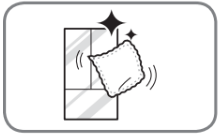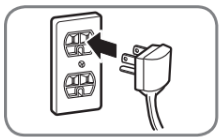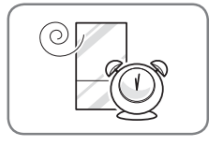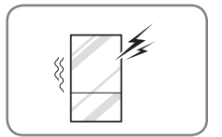Documents: Go to download!
- Owner's manual - (English, Spanish)
User Manual
COMPONENTS
Use this page to become more familiar with the parts and features of your refrigerator. Page references are included for your convenience
*The appearance and specifications of actual product may differ depending on the model
Refrigerator Exterior
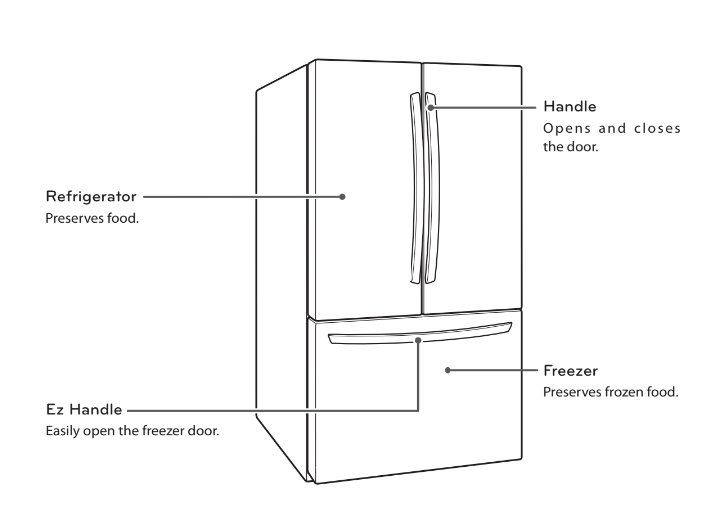
Refrigerator Interior
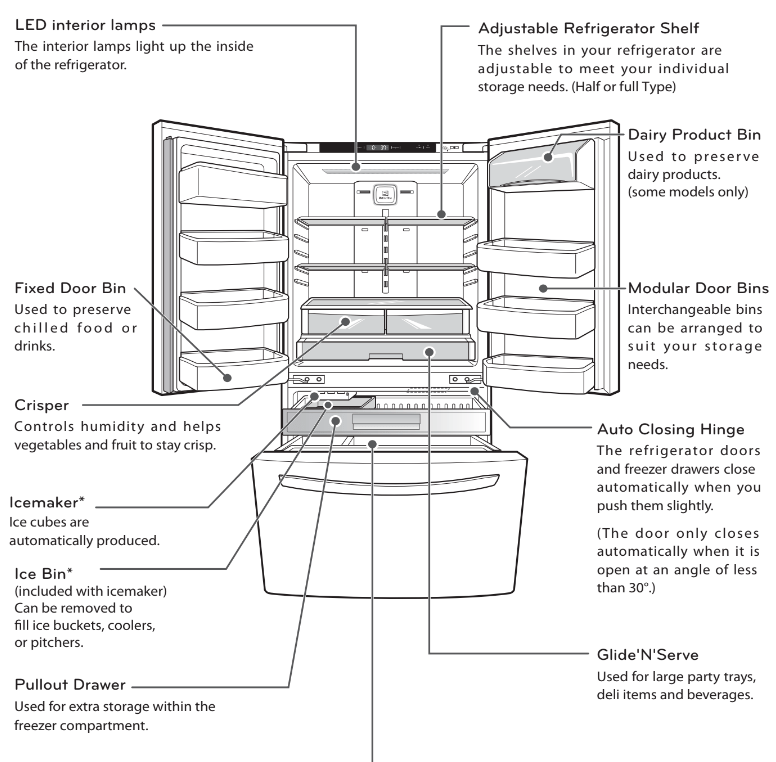
HOW TO USE
Before Use
| Clean the refrigerator. Clean the refrigerator thoroughly and wipe off all dust that accumulated during shipping. CAUTION Do not scratch the refrigerator with a sharp object or use a detergent that contains alcohol, a flammable liquid or an abrasive when removing any tape or adhesive from the refrigerator. Remove adhesive residue by wiping it off with your thumb or dish detergent. Do not peel off the model or serial number label or the technical information on the rear surface of the refrigerator. NOTE: Remove adhesive residue by wipping it off with your thumb or dish detergent. |
| Connect the power supply. Check if the power supply is connected before use. Read the “Turning On The Power” section. |
 | Turn off the icemaker if the refrigerator is not yet connected to the water supply. (Ice Maker installed only). Turn off the automatic icemaker and then plug the power plug of the refrigerator into the grounded electric outlet. * This is applicable only to certain models. CAUTION: Running the automatic icemaker before connecting it to the water supply may cause the refrigerator to malfunction. |
| Wait for the refrigerator to cool. Allow the refrigerator to run for at least two to three hours before putting food in it. Check the flow of cold air in the freezer compartment to ensure proper cooling. CAUTION: Putting food in the refrigerator before it has cooled could cause the food to spoil, or a bad odor could remain inside the refrigerator. |
| The refrigerator makes a loud noise after initial operation. This is normal. The volume will decrease as the temperature decreases. |
| Open refrigerator and freezer doors to ventilate the interior. The inside of the refrigerator may smell like plastic at first. Remove any adhesive tape from inside the refrigerator and open the refrigerator doors and the freezer drawers for ventilation. |
Control Pad
*Depending on the model, some of the following functions may not be available.
Control Pad Features

Refrigerator Temperature
Indicates the set temperature of the refrigerator compartment in Celsius (°C) or Fahrenheit (°F).
Freezer Temperature
Indicates the set temperature of the freezer compartment in Celsius (°C) or Fahrenheit (°F).
To change the temperature mode from °F to °C (or vice versa) press and hold the Refrigerator and Freezer temperature buttons simultaneously for approximately five seconds. The temperature indicator on the display window switches between Celsius and Fahrenheit.
NOTE: The displayed temperature is the target temperature, and not the actual temperature of the refrigerator. The actual refrigerator temperature depends on the food inside the refrigerator.
Ice Plus
This function increases both ice making and freezing capabilities.
- When you touch the Ice Plus button, the graphic will illuminate in the display and will continue for 24 hours. The function will automatically shut off after 24 hours
- You can stop this function manually by touching the button one more time.
Door Alarm
- When power is connected to the refrigerator, the door alarm is initially set to ON. When you press the Door Alarm button, the display will change to OFF and the Door Alarm function will deactivate.
- When either the refrigerator or the freezer door is left open for more than 60 seconds, the alarm tone will sound to let you know that the door is open.
- When you close the door, the door alarm will stop.
CAUTION
Display Mode (For Store Use Only) The Display Mode disables all cooling in the refrigerator and freezer sections to conserve energy while on display in a retail store. When activated OFF will display on the control panel and the display will remain on for 20 seconds.
To deactivate / activate: With either refrigerator door opened, press and hold the Refrigerator and Ice Plus buttons at the same time for five seconds. The control panel will beep and the temperature settings will display to confirm that Display Mode is deactivated. Use the same procedure to activate Display Mode.
Automatic Icemaker (Ice Maker installed only).
(Freezer Room)
Depending on the model, some of the following functions may not be available.
Ice is made in the automatic icemaker and sent to the dispenser. The icemaker will produce 12 cubes per cycle—approximately 120 cubes in a 24-hour period, depending on freezer compartment temperature, room temperature, number of door openings and other operating conditions.
- It takes about 12 to 24 hours for a newly installed refrigerator to begin making ice.
- The water pressure must be between 20 and 120 psi (0,14 y 0,82 MPa) on models without a water filter and between 40 to 120 psi (0,28 y 0,82 MPa) on models with a water filter to produce the normal amount and size of ice cubes.
- Foreign substances or frost on the ice-detecting sensor can interrupt ice production. Make sure the sensor area is clean at all times for proper operation.
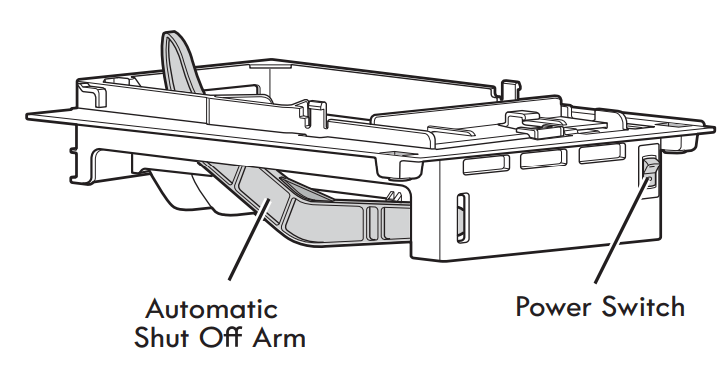
Turning the Automatic Icemaker On or Off
To turn off the automatic icemaker, set the icemaker switch to OFF (O) . To turn on the automatic icemaker, set the switch to ON (I)
CAUTION
- The first ice produced may include particles or odor from the water supply line or the water tank.
- Throw away the first few batches of ice about 24 cubes). This is also necessary if the refrigerator has not been used for a long time.
- Never store beverage cans or other items in the ice bin for the purpose of rapid cooling. Doing so may damage the icemaker or the containers may burst.
- If discolored ice is dispensed, check the water filter and water supply. If the problem continues, contact a qualified service center. Do not use the ice or water until the problem is corrected.
- Be sure nothing interferes with the sweep of the automatic shut off arm.
- It is normal for some cubes to be stuck together.
- If ice is not used frequently, old ice cubes will become cloudy, taste stale, and shrink.
- Never use thin crystal glass or crockery to collect ice. Such containers may chip or break resulting in glass fragments in the ice.
When You Should Turn the Icemaker Off
- When the water supply will be shut off for several hours.
- When the ice bin is removed for more than one or two minutes.
- When the refrigerator will not be used for several days.
NOTE: The ice bin should be emptied when the icemaker on/off switch is turned to the OFF position.
Normal Sounds You May Hear
- The icemaker water valve will buzz as the icemaker fills with water. If the power switch is in the ON (I) position, it will buzz even if it has not yet been hooked up to water. To stop the buzzing, move the power switch to OFF (O).
NOTE: Keeping the power switch in the ON (I) position before the water line is connected can damage the icemaker.
- You will hear the sound of cubes dropping into the bin and water running in the pipes as the icemaker refills.
Preparing For Vacation
Set the icemaker power switch to OFF (O) and shut off the water supply to the refrigerator.
NOTE: The ice bin should be emptied anytime the icemaker on/off switch is turned to the OFF (O) position.
If the ambient temperature will drop below freezing, have a qualified technician drain the water supply system to prevent serious property damage due to flooding caused by ruptured water lines or connections.
Storing Food
Food Preservation Location
Each compartment inside the refrigerator is designed to store different types of food.
Store your food in the optimal space to enjoy the freshest taste.
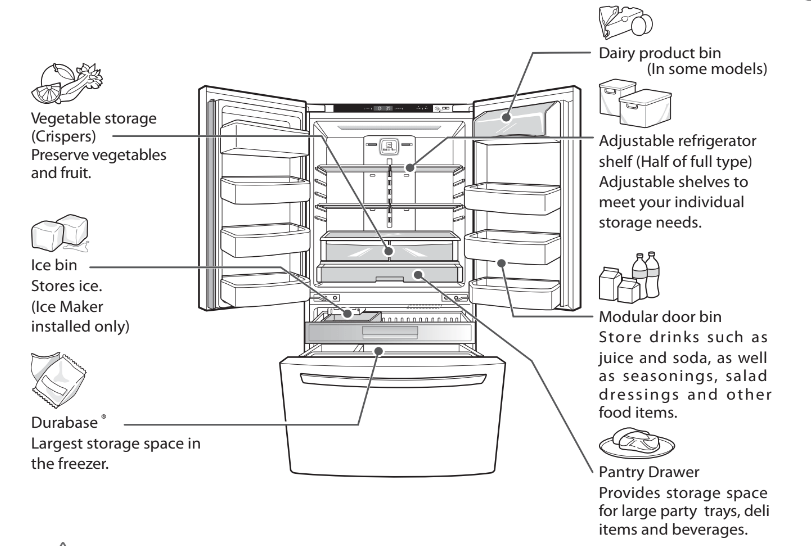
CAUTION
- Do not store food with high moisture content towards the top of the refrigerator. The moisture could come in direct contact with the cold air and freeze.
- Wash food before storing it in the refrigerator. If necessary, rinse and thoroughly pat dry vegetables and fruit to remove obvious soil, juice, or blemished areas, and wipe down food packaging to prevent adjacent foods from being contaminated.
- If the refrigerator is kept in a hot and humid place, frequent opening of the door or storing a lot of vegetable in the refrigerator may cause condensation to form. Wipe off the condensation with a clean cloth or a paper towel.
- If the refrigerator door or freezer drawer is opened too often, warm air may penetrate the refrigerator and raise its temperature. This can increase the running costs of the unit.
NOTE
- If you are leaving home for a short period of time, like a short vacation, the refrigerator should be left on. Refrigerated foods that are able to be frozen will stay preserved longer if stored in the freezer.
- If you are leaving the refrigerator turned off for an extended period of time, remove all food and unplug the power cord. Clean the interior, and leave the door open to prevent fungi from growing in the refrigerator.
Food Storage Tips
The following tips may not be applicable depending on the model.
Wrap or store food in the refrigerator in airtight and moisture-proof material unless otherwise noted. This prevents food odor and taste transfer throughout the refrigerator. For dated products, check date code to ensure freshness.
| Food | How To |
Butter or Margarine | Keep opened butter in a covered dish or closed compartment. When storing an extra supply, wrap in freezer packaging and freeze. |
Cheese | Store in the original wrapping until you are ready to use it. Once opened, rewrap tightly in plastic wrap or aluminum foil. |
Milk | Wipe milk cartons. For coldest milk, place containers on an interior shelf. |
Eggs | Store in original carton on interior shelf, not on door shelf. |
Fruit | Do not wash or hull the fruit until it is ready to be used. Sort and keep fruit in its original container, in a crisper, or store in a completely closed paper bag on a refrigerator shelf. |
Leafy Vegetables | Remove store wrapping and trim or tear off bruised and discolored areas. Wash in cold water and drain. Place in plastic bag or plastic container and store in crisper. |
Vegetables with skins (carrots, peppers) | Place in plastic bags or plastic container and store in crisper. |
Fish | Store fish and shellfish in the freezer section if they are not being consumed the same day of purchase. It is recommended to consume fresh fish and shellfish the same day purchased. |
Leftovers | Cover leftovers with plastic wrap or aluminum foil, or store in plastic containers with tight lids. |
Storing Frozen Food
NOTE: Check a freezer guide or a reliable cookbook for further information about preparing food for freezing or food storage times.
Freezing
Your freezer will not quick-freeze a large quantity of food. Do not put more unfrozen food into the freezer than will freeze within 24 hours no more than 2 to 3 lbs. of food per cubic foot of freezer space). Leave enough space in the freezer for air to circulate around packages. Be careful to leave enough room at the front so the door can close tightly.
Storage times will vary according to the quality and type of food, the type of packaging or wrap used (how airtight and moisture-proof) and the storage temperature. Ice crystals inside a sealed package are normal. This simply means that moisture in the food and air inside the package have condensed, creating ice crystals.
NOTE: Check a freezer guide or a reliable cookbook for further information about preparing food for freezing or food storage times.
NOTE: Allow hot foods to cool at room temperature for 30 minutes, then package and freeze. Cooling hot foods before freezing saves energy.
Packaging
Successful freezing depends on correct packaging. When you close and seal the package, it must not allow air or moisture in or out. If it does, you could have food odor and taste transfer throughout the refrigerator and could also dry out frozen food.
Packaging recommendations:
- Rigid plastic containers with tight-fitting lids
- Straight-sided canning/freezing jars
- Heavy-duty aluminum foil
- Plastic-coated paper
- Non-permeable plastic wraps
- Specified freezer-grade self-sealing plastic bags
Follow package or container instructions for proper freezing methods.
Do not use
- Bread wrappers
- Non-polyethylene plastic containers
- Containers without tight lids
- Wax paper or wax-coated freezer wrap
- Thin, semi-permeable wrap
Humidity Controlled Crisper and Glide’N’Serve
Humidity Controlled Crisper
Depending on the model, some of the following functions may not be available.
The crispers provide fresher tasting fruit and vegetables by letting you easily control humidity inside the drawer.
You can control the amount of humidity in the moisture-sealed crispers by adjusting the control to any setting between Vegetable and Fruit.
- Vegetable keeps moist air in the crisper for best storage of fresh, leafy vegetables.
- Fruit . lets moist air out of the crisper for best storage of fruit.
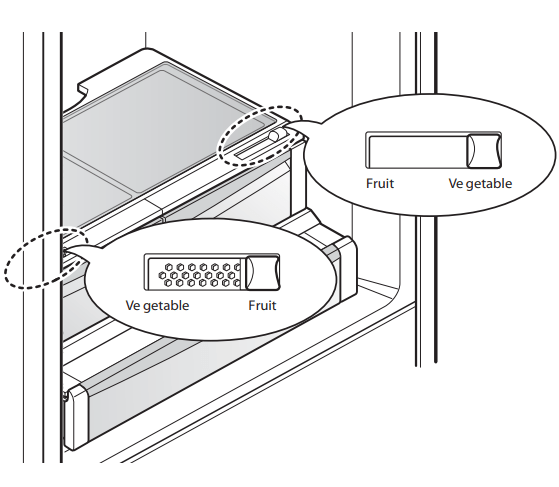
Glide’N’Serve
This drawer can be used for large party trays, deli items and beverages. (This drawer should not be used for vegetables that require high humidity.)
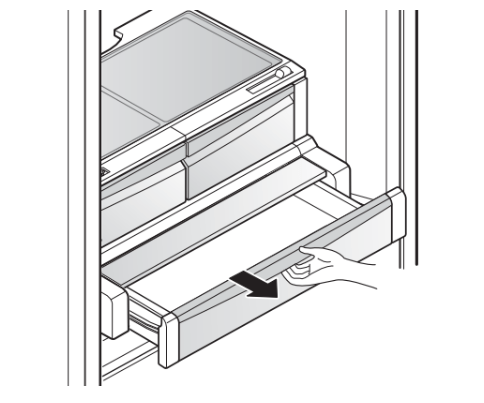
Detaching and Assembling the Storage Bins
Glide’N’Serve and Humidity Controlled Crisper
To remove the Humidity Controlled Crisper and the Glide’N’Serve1, pull out the Crisper and Glide’N’Serve2 to full extension, lift the front up, and pull straight out.
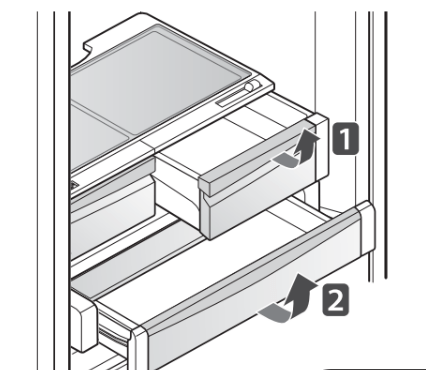
To install, slightly tilt up the front, insert the drawer into the frame and push it back into place.

ICE BIN (In some models)
- Pull the drawer as much as possible (1).
- Raise the ice box and take it out carefully (2).
- Take the drawer off as much as possible and put the ice bin in the right position (3).
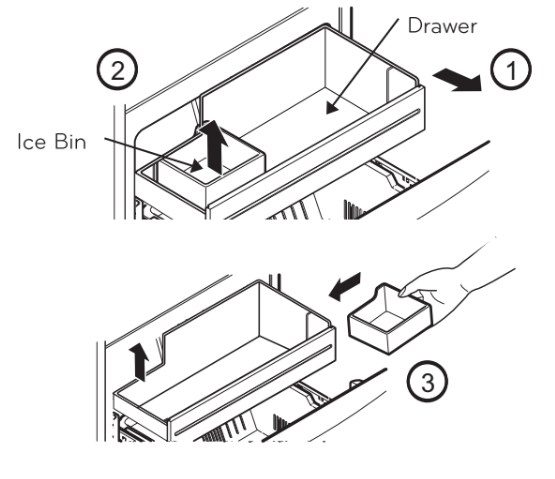
To Remove the Glass
(Pantry drawer not shown for clarity)
Lift up the glass under the crisper cover, and pull up and out.
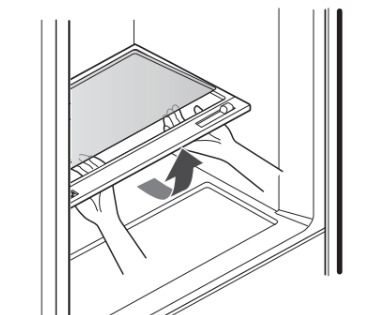
Door Bins
The door bins are removable for easy cleaning and adjustment.
- To remove the bin, simply lift the bin up and pull straight out.
- To replace the bin, slide it in above the desired support and push down until it snaps into place.
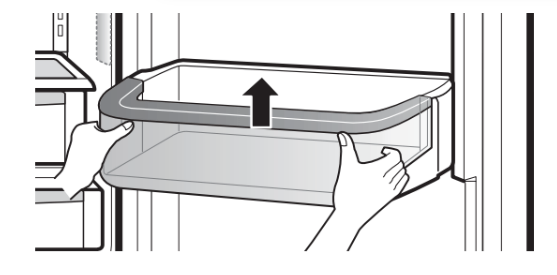
NOTE: Some bins may vary in appearance and will only fit in one location
CAUTION
- Do not apply excessive force while detaching or assembling the storage bins.
- Do not use the dishwasher to clean the storage bins and shelves.
- Regularly detach and wash the storage bins and shelves; they can become easily contaminated by the food.
Adjusting the Refrigerator Shelves
The shelves in your refrigerator are adjustable to meet your individual storage needs. Your model may have full or split shelves. want easier. Doing so will also reduce the amount of time the refrigerator door is open which will save energy.
Detaching the Shelf
Tilt up the front of the shelf and then lift the shelf straight up. Pull the shelf out.
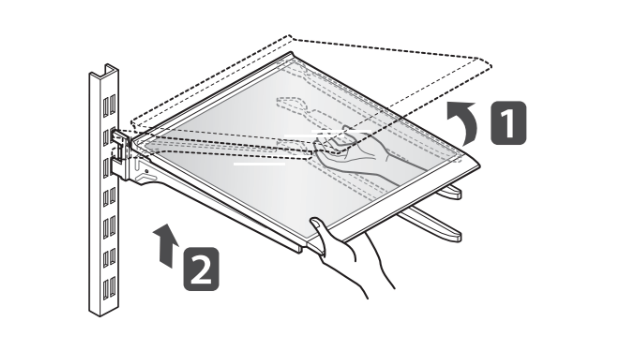
Assembling the Shelf
Tilt the front of the shelf up and guide the shelf hooks into the slots at a desired height. Then, lower the front of the shelf so that the hooks drop into the slots.

CAUTION: Make sure that shelves are level from one side to the other. Failure to do so may result in the shelf falling or spilling food.
CAUTION:
- Do not clean glass shelves with warm water while they are col . Shelves may break if exposed to sudden temperature changes or impact.
- Glass shelves are heavy. Use special care when removing them.
How to remove the full-width shelf
Lift the rear of the shelf and pull it out.
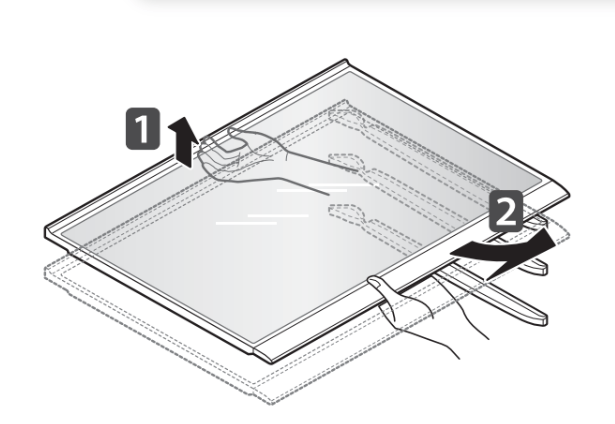
The full-width shelf placement
Slide the shelf in the guides until it stops
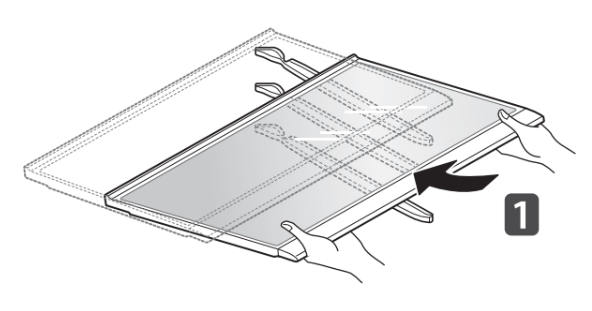
MAINTENANCE
Cleaning
- Both the refrigerator and freezer sections defrost automatically; however, clean both sections about once a month to prevent odors.
- Wipe up spills immediately.
- Always unplug the refrigeration before cleaning.
General Cleaning Tips
- Unplug refrigerator or disconnect power.
- Remove all removable parts, such as shelves, crispers, etc.
- Use a clean sponge or soft cloth and a mild detergent in warm water. Do not use abrasive or harsh cleaners.
- Hand wash, rinse and dry all surfaces thoroughly.
Exterior
Waxing external painted metal surfaces helps provide rust protection. Do not wax plastic parts. Wax painted metal surfaces at least twice a year using appliance wax (or auto paste wax).
Apply wax with a clean, soft cloth.
For products with a stainless steel exterior, use a clean sponge or soft cloth and a mild detergent in warm water. Do not use abrasive or harsh cleaners. Dry thoroughly with a soft cloth.
CAUTION
- Do not use a rough cloth or sponge when cleaning the interior and exterior of the refrigerator.
- Do not place your hand on the bottom surface of the refrigerator when opening and closing.
Inside Walls (allow freezer to warm up so the cloth will not stick)
To help remove odors, you can wash the inside of the refrigerator with a mixture of baking soda and warm water. Mix 2 tablespoons of baking soda to 1 quart of water (26 g soda to 1 liter water.) Be sure the baking soda is completely dissolved so it does not scratch the surfaces of the refrigerator.
Door Liners and Gaskets
Use a clean sponge or soft cloth and a mild detergent in warm water. Do not use cleaning waxes, concentrated detergents, bleaches, or cleaners containing petroleum on plastic refrigerator parts.
Condenser Coils
Use a vacuum cleaner with an attachment to clean the condenser cover and vents. Do not remove the panel covering the condenser coil area.
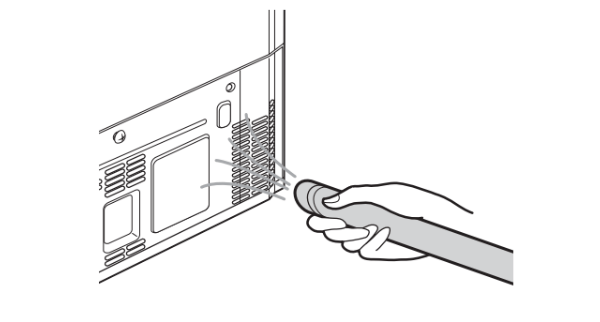
SMART DIAGNOSIS (Some models).
(Some models).
Should you experience any problems with your refrigerator, it has the capability of transmitting data via your telephone to the LG service center. This gives you the capability of speaking directly to our trained specialists. The specialist records the data transmitted from your machine and uses it to analyze the issue, providing a fast and effective diagnosis.
If you experience problems with your refrigerator, call to the LG service center. Only use the Smart Diagnosis feature when instructed to do so by the LG call center agent. The transmission sounds that you will hear are normal and sound similar to a fax machine.
Smart Diagnosis cannot be activated unless your refrigerator is connected to power. If your refrigerator is unable to turn on, then troubleshooting must be done without using Smart Diagnosis.
Using Smart DiagnosisTM
First, call to the LG service center. Only use the Smart Diagnosis feature when instructed to do so by the LG call center agent.
1. Open the refrigerator door.
2. Hold the mouthpiece of your phone in front of the speaker that is located on the right side of the control pad, when instructed to do so by the call center.
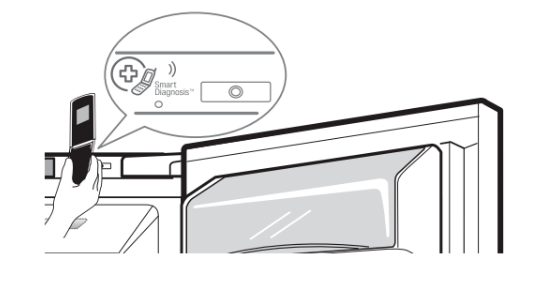
3. Press and hold the Freezer button for three seconds while continuing to hold your phone to the speaker.
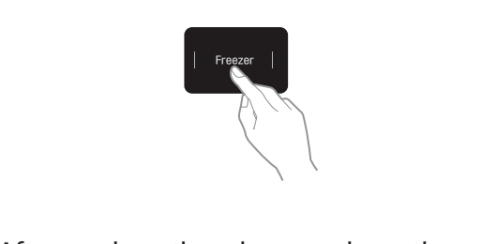
4. After you hear three beeps, release the Freezer button.
5. Keep the phone in place until the tone 3 seconds, and the display will count transmission has nished. This takes about down the time. Once the countdown is over and the tones have stopped, resume your conversation with the specialist, who will then be able to assist you in using the information transmitted for analysis.
NOTE
- For best results, do not move the phone while the tones are being transmitted.
- If the call center agent is not able to get an accurate recording of the data, you may be asked to try again.
NOTE
- Use the home telephone for better
- Call quality differences by region may region the function. communication performance, resulting in better service.
- Bad call quality may result in poor data transmission from your phone to the machine, which could cause Smart Diagnosis TM to malfunction. .
TROUBLESHOOTING
Review the Troubleshooting section before calling for service; doing so will save you both time and money.
| Problem | Possible causes | Solutions |
|---|---|---|
| Refrigerator and Freezer section are not cooling. | The refrigerator control is set to OFF (some models). | Turn the control ON. Refer to the Setting the Controls section for proper temperature settings. |
| Refrigerator is in the defrost cycle. | During the defrost cycle, the temperature of each compartment may rise slightly. Wait 30 minutes and confirm the proper temperature has been restored once the defrost cycle has completed. | |
| Refrigerator was recently installed. | It may take up to 24 hours for each compartment to reach the desired temperature. | |
| Refrigerator was recently relocated. | If the refrigerator was stored for a long period of time or moved on its side, it is necessary for the refrigerator to stand upright for 24 hours before connecting it to power. | |
| Cooling System runs too much. | Refrigerator is replacing an older model. | Modern refrigerators require more operating time but use less energy due to more efficient technology. |
| Refrigerator was recently plugged in or power restored. | The refrigerator will take up to 24 hours to cool completely. | |
| The door is opened often or a large amount of food / hot food was added. | Adding food and opening the door warms the refrigerator, requiring the compressor to run longer in order to cool the refrigerator back down. In order to conserve energy, try to get everything you need out of the refrigerator at once, keep food organized so it easy to find, and close the door as soon as the food is removed. (Refer to the Food Storage Guide.) | |
| Doors are not closed completely. | Firmly push the doors shut. If they will not shut all the way, see the Doors will not close completely or pop open section in Troubleshooting. | |
| Refrigerator is installed in a hot location. | The compressor will run longer under warm conditions. At normal room temperatures 70°F (21 °C) expect your compressor to run about 40% to 80% of the time. Under warmer conditions, expect it to run even more often. The refrigerator should not be operated above 110°F (43 °C). | |
| Condenser / back cover is clogged. | Use a vacuum cleaner with an attachment to clean the condenser cover and vents. Do not remove the panel covering the condenser coil area. | |
| Refrigerator or Freezer section is too warm. | Refrigerator was recently installed. | It may take up to 24 hours for each compartment to reach the desired temperature. |
| The air vents are blocked. Cold air circulates from the freezer to the fresh food section and back again through air vents in the wall dividing the two sections. | Locate air vents by using your hand to sense airflow and move all packages that block vents and restrict airflow. Rearrange items to allow air to flow throughout the compartment. (Refer to the Airflow diagram in the Using Your Refrigerator section.) | |
| Doors are opened often or for long periods of time. | When the doors are opened often or for long periods of time, warm, humid air enters the compartment. This raises the temperature and moisture level within the compartment. To lessen the effect, reduce the frequency and duration of door openings. | |
| Unit is installed in a hot location. | The refrigerator should not be operated in temperatures above 110°F (43 °C). | |
| A large amount of food or hot food was added to either compartment. | Adding food warms the compartment requiring the cooling system to run. Allowing hot food to cool to room temperature before putting it in the refrigerator will reduce this effect. | |
| Doors not closed correctly. | See the Doors will not close correctly or pop open section in Parts & Features Troubleshooting. | |
| Temperature control is not set correctly. | If the temperature is too warm, adjust the control one increment at a time and wait for the temperature to stabilize. Refer to the Setting the Controls section for more information. | |
| Defrost cycle has recently completed. | During the defrost cycle, the temperature of each compartment may rise slightly and condensation may form on the back wall. Wait 30 minutes and confirm the proper temperature has been restored once the defrost cycle has completed. | |
| Interior moisture buildup. | Doors are opened often or for long periods of time. | When the doors are opened often or for long periods of time, warm, humid air enters the compartment. This raises the temperature and moisture level within the compartment. To lessen the effect, reduce the frequency and duration of door opening. |
| Doors not closed correctly. See the Doors will not close correctly section in the Troubleshooting section. | Weather is humid. Humid weather allows additional moisture to enter the compartments when the doors are opened leading to condensation or frost. Maintaining a reasonable level of humidity in the home will help to control the amount of moisture that can enter the compartments. | |
| Defrost cycle recently completed. | During the defrost cycle, the temperature of each compartment may raise slightly and condensation may form on the back wall. Wait 30 minutes and confirm that the proper temperature has been restored once the defrost cycle has completed. | |
| Food is not packaged correctly. | Food stored uncovered or unwrapped, and damp containers can lead to moisture accumulation within each compartment. Wipe all containers dry and store food in sealed packaging to prevent condensation and frost. | |
| Food is freezing in the refrigerator compartment. | Food with high water content was placed near an air vent. | Rearrange items with high water content away from air vents. |
| Refrigerator temperature control is set incorrectly. | If the temperature is too cold, adjust the control one increment at a time and wait for the temperature to stabilize. Refer to the Setting the Controls section for more information. | |
| Refrigerator is installed in a cold location. | When the refrigerator is operated in temperatures below 41°F (5°C), food can freeze in the refrigerator compartment. The refrigerator should not be operated in temperatures below 55°F (13°C). | |
| Frost or ice crystals form on frozen food outside of package) | Door is opened frequently or for long periods of time. | When the doors are opened often or for long periods of time, warm, humid air enters the compartment. This raises the temperature and moisture level within the compartment. Increased moisture will lead to frost and condensation. To lessen the effect, reduce the frequency and duration of door openings. |
| Door is not closing properly. | Refer to the Doors will not close correctly or pop open section in the Troubleshooting section. | |
| Refrigerator or Freezer section is too cold. | Incorrect temperature control settings. | If the temperature is too cold, adjust the control one increment at a time and wait for the temperature to stabilize. Refer to the Setting the Controls section for more information. |
| Frost or ice crystals on frozen food (inside of sealed package). | Condensation from food with a high water content has frozen inside of the food package. | This is normal for food items with a high water content. |
| Food has been left in the freezer for a long period of time. | Do not store food items with high water content in the freezer for a long period of time. | |
| Icemaker is not making enough ice. (Ice Maker installed only). | Demand exceeds ice storage capacity. | The icemaker will produce approximately 70-210 cubes in a 24 hour period. |
| House water supply is not connected, valve is not turned on fully, or valve is clogged. | Connect the refrigerator to a cold water supply with adequate pressure and turn the water shutoff valve fully open If the problem persists, it may be necessary to contact a plumber. | |
| Water filter has been exhausted. | It is recommendation that you replace the water filter:
| |
| Low house water supply pressure. | The water pressure must be between 20 and 120 psi (0,14 y 0,82 MPa) on models without a water filter and between 40 to 120 psi (0,28 y 0,82 MPa) on the models with a water filters.If the problem persists, it may be necessary to contact a plumber. | |
| Reserve Osmosis filtration system is used. | Reserve Osmosis filtration system can reduce the water pressure below the minimum amount and result in icemaker issues. (Refer to Water Pressure section.) | |
| Tubing connecting refrigerator to house supply valve is kinked. | The tubing can kink when the refrigerator is moved during installation or cleaning resulting in reduce water flow. Straighten or repair the water supply line and arrange it to prevent future kinks. | |
| Doors are opened often or for long periods of time. | If the doors of the unit are opened often, ambient air will warm the refrigerator which will prevent the unit from maintaining the set temperature. Lowering the refrigerator temperature can help, as well as not opening the doors as frequently. | |
| Doors are not closed completely. | If the doors are not properly closed, ice production will be affected. See the Doors will not closed completely or pop open section in Parts & Features Troubleshooting for more information. | |
| The temperature setting for the freezer is too warm. | The recommended temperature for the freezer compartment for normal ice production is 0°F (–18 °C). If the freezer temperature is warmer, ice production will be affected. | |
| Refrigerator was recently installed or icemaker recently connected. | It may take up to 24 hours for each compartment to reach the desired temperature and for the icemaker to begin making ice. | |
| Icemaker not turned on | Locate the icemaker ON/OFF switch and confirm that it is in the ON (I) position. | |
| The ice detecting sensor is obstructed. | Foreign substances or frost on the ice-detecting sensor can interrupt ice production. Make sure that the sensor area is clean at all times for proper operation. | |
| The refrigerator is not connected to a water supply or the supply shutoff valve is not turned on | Connect the refrigerator to the water supply and turn the water shutoff valve fully open. | |
| Icemaker shutoff (arm or sensor) obstructed. | If your icemaker is equipped with an ice shutoff arm, make sure that the arm moves freely. If your icemaker is equipped with the electronic ice shutoff sensor, make sure that there is a clear path between the two sensors. | |
| Reverse osmosis water filtration system is connected to your cold water supply. | Reserse osmoisis filtration systems can reduce the water pressure below the minimum amount and result in icemaker issues. (Refer to the Water Pressure section.) | |
| Clicking | The defrost control will click when the automatic defrost cycle begins and ends. The thermostat control or refrigerator control on some models) will also click when cycling | Normal Operation |
| Rattling | Rattling noises may come from the on the back of the unit, or items stored on top of or around the refrigerator. | Normal Operation |
| Refrigerator is not resting solidly on | Floor is weak or uneven or leveling legs need to be adjusted. See the Door Alignment section. | |
| Refrigerator with linear compressor was jarred while running. | Normal Operation | |
| Whooshing | Evaporator fan motor is circulating air through the refrigerator and freezer compartments. | Normal Operation |
| Air is being forced over the condenser by the condenser fan. | Normal Operation | |
| Gurgling | Refrigerator flowing through the cooling system | Normal Operation |
| Popping | Contraction and expansion of the inside walls due to changes in temperature. | Normal Operation |
| Sizzling | Water dripping on the defrost heater during a defrost cycle. | Normal Operation |
| Vibrating | If the side or back of the refrigerator is touching a cabinet or wall, some of the normal vibrations may make an audible sound. | To eliminate the noise, make sure that the sides and back cannot vibrate against any wall or cabinet. |
| Dripping | Water running into the drain pan during the defrost cycle. | Normal Operation |
| Pulsating or High-Pitched Sound | Your refrigerator is designed to run items at the desired temperature. cause your new refrigerator to run longer than your old one, but it is still models. While the refrigerator is running, it is normal to hear a pulsating or high-pitched sound. | Normal Operation |
| Doors will not close correctly or pop open. | Food packages are blocking the door open. | Rearrange food containers to clear the door and door shelves. |
| Ice bin, crisper cover, pans, shelves, door bins, or baskets are out of position. | Push bins all the way in and put crisper cover, pans, shelves and baskets into their correct positions. See the Using Your Refrigerator section for more information. | |
| The doors were removed during product installation and not properly replaced. | Remove and replace the doors according to the Removing and Replacing Refrigerator Handles and Doors section. | |
| Refrigerator is not leveled properly. | See Door Alignment in the Refrigeration Installation section to level refrigerator. | |
| Doors are difficult to open. | The gaskets are dirty or sticky. | Clean the gaskets and the surfaces that they touch. Rub a thin coat of appliance polish or kitchen wax on the gaskets after cleaning. |
| Door was recently closed. | When you open the door, warmer air enters the refrigerator. As the warm air cools, it can create a vacuum. If the door is hard to open, wait one minute to allow the air pressure to equalize, then see if it opens more easily. | |
| Refrigerator wobbles or seems unstable. | Leveling legs are not adjusted properly. | Refer to the Leveling and Door Alignment section. |
| Floor is not level. | It may be necessary to add shims under the leveling legs or rollers to complete installation. | |
| Lights do not work. | LED interior lighting failure. | The refrigerator compartment lamp is LED interior lighting, and service should be performed by Replacement section. |
| Refrigerator has an unusual odor. | The Air Filter may need to be set to the MAX setting or replaced. | Set the Air Filter to the MAX setting. If the odor need to be replaced. See the Replacing the Air Filter section for replacement instructions. |
| The interior of the refrigerator is covered with dust or soot. | The refrigerator is located candle. | Make sure that the refrigerator is not located near a fire source such as a fireplace, chimney or candle. |
See other models: 49LJ5100 55SK8000PUA OLED77C8PUA 86SM9070PUA 65UK6300PUE
